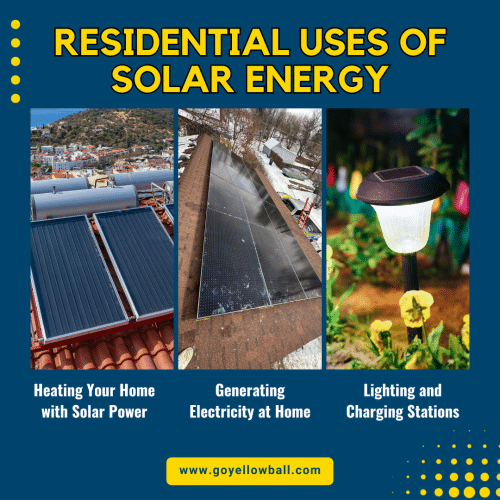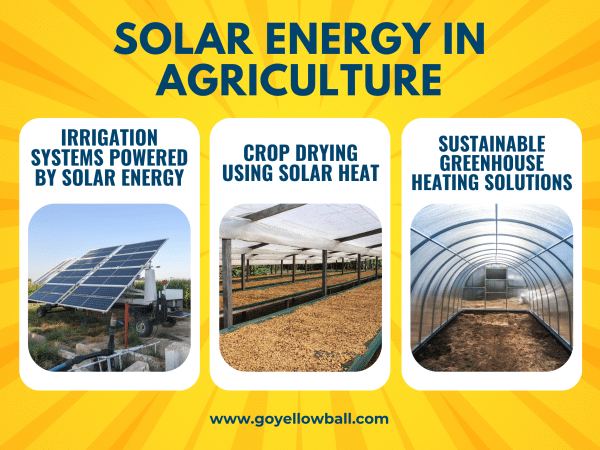The uses of solar energy extend far beyond just placing panels on rooftops; they are revolutionizing how we power our daily lives. This energy source is making significant impacts on everything from local businesses and homes to agriculture.
In our guide, we explore the wide-ranging applications of solar energy, highlighting its ability to cut costs for businesses, enhance residential energy systems, and support sustainable farming practices.
We’ll look into the latest solar technology innovations, how they reshape industries, and the benefits to public infrastructure projects. We also cover solar energy’s role in education, fostering innovation and learning, and speculate on its potential to transform future transportation methods.
Join us as we delve into the diverse uses of solar energy, showcasing its role in paving the way for a cleaner, sustainable future.
Ready to make your home a model of sustainability and efficiency? Contact YellowBall Roofing & Solar today and take the first step towards a greener, more cost-effective future.
Table Of Contents:
- The Transformative Power of Solar Energy in Local Businesses
- Residential Uses of Solar Energy
- Solar Energy in Agriculture
- Innovations in Solar Technology
- The Role of Solar Energy in Public Infrastructure
- Educational Institutions Embracing Solar Energy
- The Future of Transportation Powered by Solar Energy
- FAQs about Uses of Solar Energy
The Transformative Power of Solar Energy in Local Businesses
More and more local businesses are turning to solar power because it’s good for the environment and saves money.
Going green means these businesses are changing how they work and building stronger connections with their customers.
Cost Savings on Operations
Solar power has proven to be a game-changer for reducing operational costs. Tapping into solar energy allows companies to lower their power expenses, leading to substantial savings significantly.
The initial investment in solar panels quickly pays off as monthly energy expenses decrease. Beyond the immediate cutbacks in utility bills, numerous municipal authorities extend rewards and deductions to enterprises embracing renewable energy through solar energy applications.
These financial perks make the switch even more appealing and economically viable.
Boosting Sustainability Credentials
Becoming eco-friendly does more than help the planet; it significantly boosts a business’s brand image. Nowadays, people are more inclined to back companies genuinely caring about ecological matters.
Adopting solar energy is a visible step towards sustainability that resonates well with customers.
When businesses adopt eco-friendly practices, they attract customers who care about the environment, get positive attention from the media, and build better relationships with the community.
This makes people think even more highly of the company.
Redefining Business Through Innovation
Integrating renewable energy sources like solar isn’t just about keeping up with trends but leading through innovation.
Forward-thinking local businesses are leveraging advanced technologies like smart grids connected to their solar panel systems.
This enables them to use solar electricity and sell electricity back to the grid—turning an expense into potential revenue.
This innovative approach demonstrates how embracing green technology leads to economic resilience and sets new industry standards regarding efficiency and responsibility toward future generations.
Residential Uses of Solar Energy
Solar energy revolutionizes homeowners’ living experience by offering more than just electricity.
As we explore how solar energy impacts daily life, we discover how it brightens homes and enhances everyday experiences.
 Heating Your Home with Solar Power
Heating Your Home with Solar Power
Harnessing the sun’s rays to warm your living spaces may sound futuristic, but it’s made possible by today’s technology.
Solar water heaters harness the sun’s rays, transforming them into thermal energy to warm household water through a solar collector, reflecting a shift towards renewable energy sources in everyday life.
This solar water heating method is efficient and sustainable, utilizing solar collectors as the primary component in these water heating systems.
By absorbing solar radiation and converting it into heat, these systems efficiently provide hot water without conventional energy sources, illustrating solar energy’s practical and eco-friendly applications in modern water heating solutions.
This innovation not only diminishes our dependency on conventional heating techniques but also dramatically cuts down on household energy expenses.
In addition to solar heating, solar air heating systems are progressing in keeping indoor spaces cozy during cold months without costing a fortune.
These systems use air as the working fluid for absorbing and transferring solar heat directly into the interior space or to storage for later use.
Generating Electricity at Home
One of the most direct uses of residential solar energy is electricity generation through solar PV (photovoltaic) panels.
Adopting this method, homeowners not only reduce their electricity expenses but sometimes can even monetize the surplus energy by selling it back to the utility company via net metering contracts.
The satisfaction of watching your electric meter run backward because you generate electricity back into the local utility is something special.
Innovative Applications: Lighting and Charging Stations
Besides powering appliances or heating your home, solar energy has found its way into everyday life through innovative applications such as outdoor lighting solutions powered by miniature PV cells that automatically store daylight and illuminate pathways at night.
An even more practical application gaining popularity involves installing personal charging stations for electronic devices – all powered by one’s mini-solar setup. Imagine never having to pay to charge your smartphone again.
Solar Energy in Agriculture
Embracing solar energy within the agriculture sector is not just about going green; it’s a practical move towards cost-efficiency and sustainability.
Agriculturists are creatively adopting solar energy to boost their farms’ output and reduce ecological footprints.
 Irrigation Systems Powered by Solar Energy
Irrigation Systems Powered by Solar Energy
The heart of any farm is its irrigation system, which can be both energy-intensive and costly. Switching to solar-powered pumps allows farmers to cut down on electricity bills significantly.
Using the sun’s rays, these systems send renewable energy to pumps that water large agricultural areas, ensuring crops receive the moisture they need without spending as much money.
This method isn’t just cost-effective; it’s also reliable. Even when the sky is overcast, solar panels can produce energy, serving as a dependable power supply throughout all seasons.
Moreover, for remote farms where access to the grid might be challenging or expensive, solar irrigation offers a lifeline that keeps water flowing consistently.
Crop Drying Using Solar Heat
Drying is crucial for preserving grains and fruits post-harvest but traditionally relies heavily on fossil fuels or electricity.
By utilizing solar dryers, farmers can harness natural heat from sunlight, reducing reliance on non-renewable resources and decreasing operational costs substantially.
Besides being eco-friendly and economical, solar dryers offer more control over drying conditions than open-air methods—resulting in higher quality produce ready for market faster than traditional means allow.
Sustainable Greenhouse Heating Solutions
Extending growing seasons or cultivating plants unsuitable for local climates naturally requires heating greenhouses—a process known as ‘forcing.’
Traditional heating methods can quickly become financially expensive during colder months when demand increases dramatically alongside rising fuel prices.
Adopting solar greenhouse heaters offers farmers a sustainable way to harness free warmth directly from sunlight.
This is achieved through strategic design principles, such as constructing south-facing walls with transparent materials like glass or polycarbonate panels, which are specifically designed to trap heat efficiently inside the greenhouse throughout the winter months.
This method eliminates the need for extra fuel consumption and the daily charges that come with it.
Furthermore, this approach conserves funds in the long run and contributes to a greener planet by significantly reducing the carbon footprint associated with traditional heating methods.
It underscores the transformative power of solar energy in reshaping farming practices worldwide, steering them towards a more sustainable and environmentally friendly direction.
Innovations in Solar Technology
Solar tech is rapidly advancing, breaking through previously thought unbreakable limits. One of the fascinating developments is the emergence of floating solar farms.
Floating solar farms showcase human ingenuity by elegantly solving the issue of limited land space and repurposing water surfaces for energy production.
Floating solar farms use unused water bodies to generate clean energy without taking up valuable real estate. This approach increases our capacity to harness solar power and helps reduce evaporation from these water bodies, making it a win-win situation.
Another groundbreaking innovation is wearable portable solar devices. Imagine charging your smartphone or powering your smartwatch simply by going about your day under the sun.
Integrating solar cells into clothing has revolutionized how we access and utilize renewable energy, making it effortlessly convenient.
The Role of Solar Energy in Public Infrastructure
Solar energy is becoming a cornerstone of public infrastructure, transforming how communities power their streets, transport systems, and buildings.
Adopting solar isn’t solely for environmental friendliness—it’s equally about enhancing operational efficiency and optimizing expenses.
Street Lighting Powered by the Sun
One of the most visible signs of solar integration into public infrastructure is street lighting.
Urban areas are transitioning from classic electric lighting to solar energy alternatives globally.
Switching to solar street lighting reduces energy costs and lowers the carbon footprint. A study shows that solar streetlights can save up to 70% in electricity costs compared to conventional lighting.
Solar street lights provide illumination in areas where traditional power grids are unavailable, making it practical and cost-effective to light areas where wired lamps were previously impractical or too expensive to install.
Moreover, because they’re self-sufficient, these lights continue operating even during power outages caused by natural disasters or maintenance issues.
Solar Panels on Public Transportation Hubs
Bus stations and train depots are ideal locations for solar panel installations. They have large roof spaces typically unobstructed from sunlight, making them perfect candidates for harvesting solar energy.
Electricity from the sun powers everything within these stations, from lights to information screens, promoting environmental conservation and teaching commuters the importance of sustainable habits through renewable energy in public transportation.
Energizing Community Centers with Solar Power
Community centers serve as gathering spots for education programs, social services events, and recreational activities – all requiring significant amounts of electrical power.
Outfitting community hubs with solar arrays, either atop buildings or in adjacent clearings, empowers them to generate their electricity.
They reduce operational costs, allowing them to put more resources back into serving their communities effectively. In addition, creating a cleaner air environment everyone enjoys.
Moreover, beyond cost savings, the lasting benefits include educating future generations on the importance of sustainability by directly experiencing renewable energy sources like solar power in everyday life, a vital step in our journey towards a more sustainable Earth.
Educational Institutions Embracing Solar Energy
Today, educational centers are embracing solar power for its environmental benefits and to provide practical learning experiences for students.
This shift towards eco-friendliness is a significant step in preparing learners for a more environmentally conscious future.
Power Generation and Cost Savings
Across the nation, schools are embracing sustainability by outfitting rooftops, parking areas, and vacant land with solar panels. These schools reduce their electricity bills by harnessing the sun’s power.
A shining example is the SEIA initiative showcasing how K-12 schools can save millions of dollars annually through solar installations.
Beyond immediate savings, these systems serve as long-term investments. With minimal maintenance requirements and decades-long lifespans, solar panels ensure that educational institutions can allocate more funds toward enhancing student learning experiences rather than covering utility expenses.
Educational Benefits and Sustainability Initiatives
Solar energy projects offer invaluable hands-on learning opportunities for students interested in science, technology, engineering, and mathematics (STEM).
Schools teach students about renewable energy technologies and strategies for mitigating climate change by integrating solar data monitoring into their programs.
Initiatives like the EPA’s Green Power Partnership highlight the importance of educational programs focused on renewable energy sources.
Furthermore, sustainability initiatives gain momentum when students see their school’s commitment to green practices.
This active participation fosters a culture of environmental stewardship among young learners and often inspires community-wide efforts toward sustainability.
Additionally, various universities offer unique programs or comprehensive studies in green energy, preparing future leaders in this critical field with the necessary knowledge and skills.
By harnessing the sun’s power, schools illuminate their campuses and act as beacons of learning, offering hands-on experiences and comprehensive educational modules.
Through these teachings, schools impart essential knowledge about preserving and innovating for the future of our world.
The Future of Transportation Powered by Solar Energy
Electric Vehicles and Solar Integration
Harnessing the sun’s power is transforming our perspective on electric transport options. With the rise in solar-powered charging stations, owning an EV has become more practical.
Equipped with solar panels, these stations direct clean energy directly into your vehicle, making the idea of sustainable driving more achievable.
The collaboration of solar energy with electric vehicles is a game-changer, cutting down on greenhouse gases and lessening our dependency on non-renewable energy sources.
Firms like Tesla are leading the charge, crafting Superchargers that utilize solar power, offering motorists a swift and green method to recharge their vehicles.
The beauty of this setup lies in its simplicity and efficiency—drivers can recharge their vehicles with renewable energy from the sun while minimizing carbon footprints.
Solar-Powered Public Transit Systems
City transportation networks are increasingly adopting solar energy as a feasible clean power source.
Buses and trains equipped with solar panels can operate more sustainably by using sunlight converted into electricity.
This shift not only helps reduce operational costs over time but also contributes significantly towards lowering urban air pollution levels.
By weaving solar tech into our buses and trains, we’re crafting a greener path that’s good for our lungs and the planet, showcasing a brilliant example for cities across the globe to follow.
Innovative Charging Stations for Tomorrow’s Needs
Crafting groundbreaking charging stations is pivotal in bringing eco-friendly travel options to all corners of the globe.
These advancements, from highways with embedded photovoltaic cells to parking lots with individual chargers for every spot, facilitate greater adoption rates among consumers concerned about range limitations or infrastructure support.
They pave the way for widespread acceptance of eco-friendly travel options.
FAQs about Uses of Solar Energy
What are 5 uses of solar energy?
Solar power lights up homes, fuels businesses, powers gadgets, heats water, and runs cars. It’s versatile.
What is solar energy used for in everyday life?
In daily life, solar charges phones, cooks food, keeps houses warm or cool, and lights streets at night.
What else is solar energy used for?
Beyond the basics, it powers farms’ irrigation systems and tech devices like wearables. It also purifies water.
How is solar energy useful to life on Earth?
Solar reduces fossil fuel use. This cuts pollution and greenhouse gases. It is good for health and climate both.
What is a solar thermal power plant?
A solar thermal power plant generates electricity by concentrating sunlight with mirrors or lenses onto a receiver, heating a fluid to produce steam. This steam drives a turbine, converting solar energy into electricity, differing from solar panels that directly convert sunlight.
Embracing Solar Energy for a Brighter Future
Harnessing the sun’s rays, through the uses of solar energy, is transforming our planet, cutting down expenses for companies, and bringing a fresh wave of energy to our living spaces.
Agriculture is transforming, energized by solar energy, which introduces cutting-edge technologies and illuminates our public spaces in ways we never imagined.
Remember, solar energy isn’t just for generating electricity. It can also heat your home, dry crops, and power future forms of transportation. Its uses are wide-ranging and varied.
Dive into solar energy for cost savings, sustainability, or to join a greater cause. Its potential is unlimited. If you’re ready, start exploring how solar can light up your path today.
Reach out to YellowBall Roofing & Solar for innovative solutions to make your home more energy-efficient. Your journey towards a sustainable home starts here.


.png)


